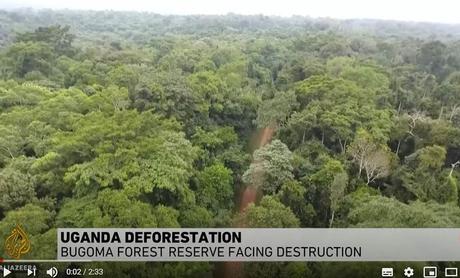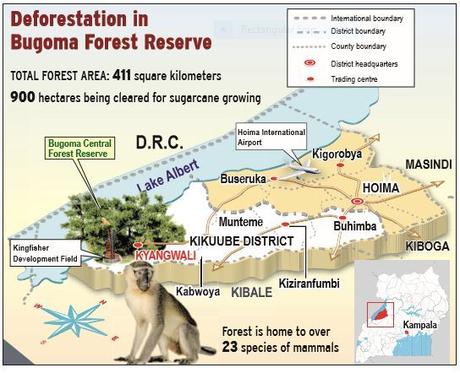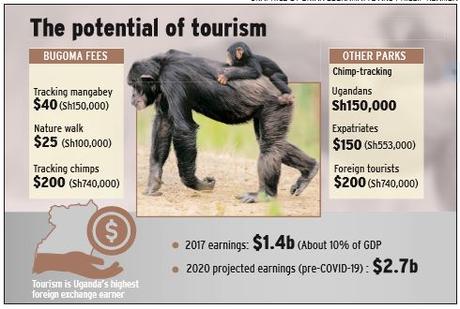
Bugoma Forest: A garden of Eden under threat.
As regular Diary of a Muzungu readers know, I'm passionate about the environment. It's devastating to hear how advanced the plans are to destroy yet more indigenous forest. The campaign to #SaveBugomaForest is gathering momentum - but do we have time? I'm delighted to see the New Vision Group promoting the cause to save Bugoma Forest. Thank you to New Vision Group for allowing me to republish this article by Gerald Tenywa, first published by them on 30th September 2020.
Scroll down to watch a short video clip from Malcolm Webb of Al Jazeera entitled Uganda: Bugoma forest reserve facing destruction.
Vision Group begins a campaign to save Bugoma Forest.
ENVIRONMENT | #SAVEBUGOMAFOREST
A chunk of Bugoma Forest Reserve is being cleared for sugarcane growing. There is no doubt this will bring jobs and some social services closer to the people. But the encroachment could start and soon the whole forest will be gone. Dire climate change consequences will follow. Today, Vision Group begins a campaign to save Bugoma Forest.
The birds chirp in the trees. Not far away, black and white colobus monkeys shy away as a tiny path into the wildlife sanctuary unveils what part of the 41,000ha Bugoma Forest Reserve offers. The birds and monkeys are part of Bugoma Central Forest. It is their natural home. But they are threatened with eviction as part of the forest is being cleared for sugarcane growing.
The National Environment Management Authority (NEMA), gave a go-ahead to the sugar project, an indication that it sees no negative impact on the environment when the forest is replaced by sugarcane. Yet, once it is cleared the birds and chimpanzees will not have a home.
Already, they have been under threat from farmland and logging activities. A Vision Group team is in the forest, accompanied by Nazario Asiimwe, a tour guide. Chimpanzees cry out, jumping from one tree to another.
Asiimwe explains the loud cries as grumbling because the chimps are not comfortable with the intrusion into their homeland. "This is one of the better days when you do not have to labour to see some of Bugoma's best kept secrets," Asiimwe says.
He explains that on some days you have to walk for hours before you can spot a chimpanzee or colobus monkey.
Costantino Tessarin, an investor in tourism accommodation, says Bugoma is endowed with chimpanzees. He points out that some of them are undergoing habituation.
Habituation is a process through which primates such as chimpanzees get used to human presence without losing their wild character. The habituation of the chimps in Bugoma started last year and they could be open to tourism in the coming year.
 Deforestation in Bugoma Forest Reserve. COURTESY New Vision Uganda. Article by Gerald Tenywa
Deforestation in Bugoma Forest Reserve. COURTESY New Vision Uganda. Article by Gerald Tenywa
Already, primate tourism in Bugoma is generating a lot of interest. This is because an endemic species of monkeys known as the Ugandan mangabey has become an eye-catcher for tourists. "Ugandan mangabeys are the flagbearers of Bugoma," Tessarin says, adding that animals are also being re-introduced in the nearby Kabwoya Wildlife Reserve.
Tessarin says to track the Ugandan mangabey, tourists have to part with $40 (sh150,000). This is higher than the nature walk which goes for $25 (sh100,000). Tracking chimps could go for as a high as $200 (sh740,000).
In other parks with chimps, Ugandans part with sh150,000 to track them. Resident non-nationals (expatriates) pay $150 (sh553,000) and foreign tourists $200 (740,000). Tourism is the highest foreign exchange earner in Uganda.
In 2017, Uganda earned $1.4b from the sector. This was expected to double to $2.7b (sh9.8 trillion) by 2020. Tourism earnings are about 10% of Uganda's Gross Domestic Product, according to the Uganda Tourism Board.
Given that Hoima is located only 200 km from Kampala, Bugoma and Kabwoya could become the tourism destination nearest to Kampala. Mbarara where Lake Mburo National Park is found and Mbale that is blessed with Mt. Elgon National Park are located 240km from the capital city. Murchison Falls National Park is 203 km away.
BIG TOURISM POTENTIAL
Tessarin says the tourism potential of Bugoma and Kabwoya wildlife reserve is immense, but is barely being scratched.
He says Bugoma promises to become a stopover for tourists heading to the northern tourist circuit ( Murchison Falls National Park) and the southern tourist circuit ( Queen Elizabeth National Park, Kibale National Park and Bwindi Impenetrable National Park).
The prospects of Bugoma and Kabwoya as a stopover have increased with the construction of the road linking the Kampala-Gulu highway to Fort Portal through Kigumba, Masindi, Hoima and Kyenjojo.
 Tourism potential Save Bugoma Forest Uganda. COURTESY New Vision Uganda. Article by Gerald Tenywa
Tourism potential Save Bugoma Forest Uganda. COURTESY New Vision Uganda. Article by Gerald Tenywa
In addition to the Kigumba-Kyenjojo road, Bunyoro has been networked with the construction of the oil roads. The connectivity will increase further with the construction of Hoima International Airport.
The discovery of oil is also bringing many people, including workers and expatriates, to Hoima and Buliisa. This could become part of the market Bugoma and Kabwoya should be looking up to. "Bugoma could be the new tourism hub," Tessarin says.
In 2018, the hotel hosted 196 tourists. The number increased to 276 last year. This year, the numbers were projected to increase to 350400 before COVID-19 spoilt Bugoma's party.
Another accommodation facility was supposed to be set up at Lwera. However, the investment in a second lodge is being discouraged by the encroachment on Bugoma by the expansive sugarcane plantation.
SUGARCANE IN BUGOMA
Hoima Sugar Limited, a private company, is moving into the heart of Bugoma, clearing part of the ancient forest for growing of sugarcane. The sugar company leased the land from Gafabusa Iguru, the king of Bunyoro.
This was three days after the Bunyoro king acquired a land title for the land, which also houses a cultural site for the kings of Bunyoro. This land was carved out of Bugoma after the king of Bunyoro claimed ownership of the land adding that not far from Bugoma are Kabwoya and Lake Albert.
At Bugoma, Tessarin is turning his dreams into reality. He has built Jungle Lodge at the fringes of Bugoma Forest.
As Hoima Sugar clears 5,779.7ha, part of Bugoma near Nsozi in Kyangwali sub-county, MZ Agencies is also clearing a swathe of forest sitting on 2,000ha from Kisaru. The two investments are eating into the heart of Bugoma towards Kaseeta.
Mustafa Zaidi, a tycoon in Hoima city, owns MZ Agencies. This will not only destroy the beauty of Bugoma, but also pose a risk to the chimps that are categorised as endangered species. Muhangaizima, where the companies are operating, is where most of the 600 chimps housed by the forest stay.
"The chimps are going to lose their habitat," says Bashir Hangi, the public relations manager of Uganda Wildlife Authority. "Do you know what this means? Human-wildlife conflicts are going to escalate. The chimps are going to get into contact with the human population and grab their children as well as destroy crops."
Link to original article on New Vision.
SAVE BUGOMA FOREST CAMPAIGN supporters include the Uganda Tourism Association, Association of Uganda Tour Operators, Association of Uganda Tour Guides, Association of Uganda Travel Agents, Uganda Jungle Lodges Ltd, Rosaline Place LTD, Destination Jungle Ltd, NGO Uganda Coalition, Association for the Conservation of Bugoma Forest, Association of Scouts of Uganda, Chimpanzee Sanctuary and Wildlife Conservation Trust, Joint Energy and Environment Projects (JEEP), Tree Talk Plus, Care International, ACODE, Youth Leading Environment Change (YLEC), Bugoma Chimpanzee Project, Eco-trust, NAPE.

